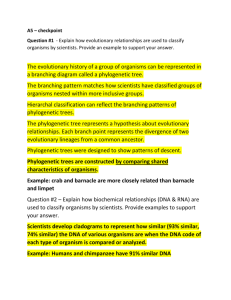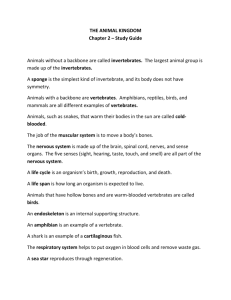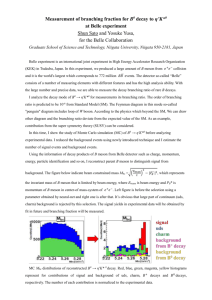Activity Template
advertisement
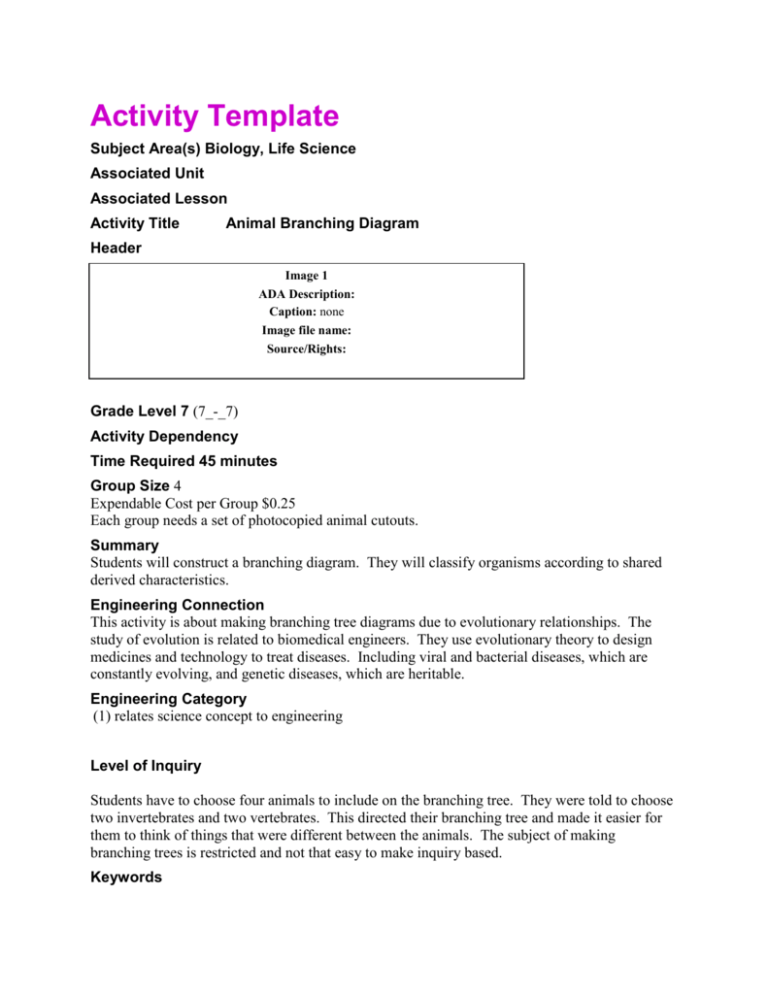
Activity Template Subject Area(s) Biology, Life Science Associated Unit Associated Lesson Activity Title Animal Branching Diagram Header Image 1 ADA Description: Caption: none Image file name: Source/Rights: Grade Level 7 (7_-_7) Activity Dependency Time Required 45 minutes Group Size 4 Expendable Cost per Group $0.25 Each group needs a set of photocopied animal cutouts. Summary Students will construct a branching diagram. They will classify organisms according to shared derived characteristics. Engineering Connection This activity is about making branching tree diagrams due to evolutionary relationships. The study of evolution is related to biomedical engineers. They use evolutionary theory to design medicines and technology to treat diseases. Including viral and bacterial diseases, which are constantly evolving, and genetic diseases, which are heritable. Engineering Category (1) relates science concept to engineering Level of Inquiry Students have to choose four animals to include on the branching tree. They were told to choose two invertebrates and two vertebrates. This directed their branching tree and made it easier for them to think of things that were different between the animals. The subject of making branching trees is restricted and not that easy to make inquiry based. Keywords Animal, branching tree, shared derived characteristics, invertebrates, and vertebrates Educational Standards State science: Branching tree diagram 7.3.d Students know how to construct a simple branching diagram to classify living groups of organisms by shared derived characteristics and how to expand the diagram to include fossil organism. Structure and Function of Living Organisms. 7.5 The anatomy and physiology of plants and animals illustrate the complementary nature of structure and function. As a basis for understanding this concept 7.5.a Students know plants and animals have levels of organization for structure and function, including cells, tissues, organs, organ systems and whole organism. Pre-Requisite Knowledge This activity would work best with students that have already been exposed to different kinds of animals. The animals that they should know about are: sponges, cnidarians, worms, mollusks, echinoderms, arthropods, and some knowledge about vertebrates. Specifically information their symmetry, skeletons, and other morphology. Learning Objectives After this activity, students should be able to: Classify different types of animals Describe the difference between an invertebrate and a vertebrate animal Explain what a shared derived characteristic is. Make a branching diagram Add an extinct animal to their branching diagram Materials List Each group needs: Set of photocopied animals (this should include both invertebrate and vertebrate animals) A hand out for each student To share with the entire class: none Introduction / Motivation Scientists and other people classify organisms in order to better understand them and to describe them to other people. Species are grouped in to units that can reproduce among themselves. People use branching trees to show evolutionary relationships among different species. They use shared derived characteristics, which are a homologous traits that is inherited from a common ancestor. Animals are split into two main groups vertebrates and invertebrates. Vertebrates have in internal skeleton with a backbone and invertebrates do not. The students will draw evolutionary relationships by making a branching tree diagram. It is possible to fit extinct animals on the trees by using what we know about their bodies. Vocabulary / Definitions Word Definition Branching A picture that shows evolutionary relationships between organisms. Scientists Tree Diagram use both morphological characteristics and DNA evidence to make them. Shared A homologous trait that is shared by all members of a group. Derived Characteristic Homologous A part of an organism that was inherited from its ancestral species. A good Trait example is the bones in the arm of a human, wing of bird and flipper of a seal. Vertebrate An animal that has an internal backbone Invertebrate An animal that does not have an internal backbone Procedure Background Give the students background about branching diagrams, and invertebrate and vertebrate animals. Before the Activity Make copies of the hand out and the animal photo cut outs With the Students 1. Go through the introduction 2. Break up the students in to groups of 4 3. Give each group the animal cut outs. 4. Have the students sort the animals into invertebrate and vertebrate animals 5. Draw a branching diagram and answer the questions on the hand out. 6. Conclusion Image Insert Image # or Figure # here, [note position: left justified, centered or right justified] Figure 1 ADA Description: ___? Caption: Figure 1: ___? Image file name: ___? Source/Rights: Copyright © ___? Attachments Animal branching diagram hand out Safety Issues none Troubleshooting Tips Students have a really hard time grouping animals into vertebrate and invertebrate animals even if they can tell that it’s a certain kind of animal. For example they can tell that a lobster is a crustation but they do not know that it is an invertebrate. We had too many animals for them to sort and the activity took too long. Also it was important to choose very different animals to make the branching diagram. For example it was better for them to pick a mollusk and an arthropod rather than two arthropods because there are more obvious differences. Also students tried to pick traits like lives in the sea. Which is not a good marker of evolutionary relationships. Also the students frequently made correct for this activity but scientifically incorrect branching diagrams. Investigating Questions Students could figure out the correct evolutionary relationships by looking them up on the Internet or in a book. Assessment Pre-Activity Assessment Title: Warm up Activity Embedded Assessment Title: Animal Branching Tree Diagram Post-Activity Assessment Title: Lab Reflection Get the students to write a paragraph about what they thought of the lesson. What they learned and what was hard. Activity Extensions Activity Scaling For less advanced: Give them more direction about which animals to use For more advanced: Don’t give them as much specific instruction about which animals to use Additional Multimedia Support References Other Redirect URL [For TE submissions only] Owner Thea Wang, UCLA Science and Engineering of the Environment of Los Angeles, NSF GK12 Contributors This activity was adapted from a hand out made by Katherine Peace. This activity has been classroom tested in the 7th grade classrooms at Culver City Middle School within the Culver City Unified School District California. Copyright


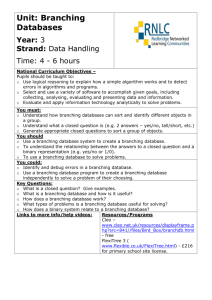
![Branching Out: An Introduction to Family History [pptx , 2.3 MB]](http://s2.studylib.net/store/data/005232376_1-8bb1ea3bff509441ce8b545117622545-300x300.png)

